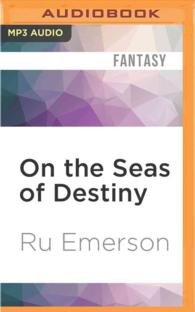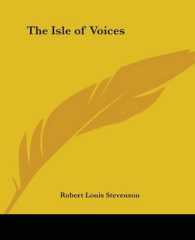- ホーム
- > 洋書
- > 英文書
- > Science / Mathematics
Full Description
Preservation of nature and the environment has become one of the most important issues of the end of the twentieth century. It has become evident that the methods used for industrial and agricultural production in many countries produce pollutants that cannot undergo natural neutralization by entering the atmosphere, soil or water. Ecosystems that have been developing for centuries are undergoing degradation and what is even more regrettable is that there is an actual threat of profound disorder in the biosphere which could lead to heavy and irreversible changes. Fluorine derivatives are the most aggressive among toxic compounds polluting the atmosphere. Moreover, the percentage of fluorides in industrial emissions is constantly increasing with the bulk of fluorides being emitted by aluminium smelters. Fluorine is poorly detoxified by both plants and animals and the accumulation of even relatively low concentrations over a long period causes a cumulative toxic effect. Among woody plants conifers are less resistant to fluorine. Fluorine derivatives as phytopollutants have been studied less than sulphur compounds, nitrogen oxides, chlorine and hydrogen chloride. It was not until the late 1960s when there was a rapid decline of coniferous forests that researchers directed their attention towards phyto toxic properties of fluorides.
Contents
Introduction: The Problem; Aims and Methods of Research.- 1 Fluorine as a Pollutant, Its Compounds in Industrial Emissions. Formation and Structure of Damaged Areas in Coniferous Forests.- 1.1 Acid Pollutants from Industrial Emissions and Role of Fluorides as Acid Pollutants.- 1.2 Fluorides in Emissions from Aluminium Smelters and Their Accumulation in Polluted Areas.- 1.3 The Effect of Mixing Hydrogen Fluoride with Other Acid Pollutants.- 1.4 The Spread of Fluorine from Emission Source.- 1.5 Formation of Zones that Differ in Fluorine Concentration and Extent of Conifer Damage.- 1.6 Summary.- 2 Resistance of Conifers to Fluorine. Tree Decline.- 2.1 General, Species and Individual Resistances.- 2.2 Factors Responsible for Duration of the Tree Decline Process.- 2.3 Accumulation of Fluorine by Trees in Zones Varying in Fluorine Concentration.- 2.4 Changes in Chemical Composition of Pine Needles in the Zone of Emissions from Aluminium Smelters.- 2.5 Dynamics of Seasonal Fluorine Accumulation and Injury of Trees.- 2.6 Reduction in Annual Wood Growth and Extent of Xylem Flow with Tree Decline.- 2.7 Summary.- 3 Fluorine Toxicosis in Conifers.- 3.1 The Corrosive Burn and Toxicosis in Plants.- 3.2 Pathways of Fluorine Entry into the Plant; Its Translocation, Localization and Removal.- 3.3 The Effect of Hydrogen Fluoride on Physiological-Biochemical Processes in Conifers.- 3.4 Summary.- 4 The Role of Insects in Fluorine-Damaged Stands.- 4.1 The Effect of Fluorine on Insects.- 4.2 The Reduction in Mechanisms of Plant Resistance to Damage by Insects.- 4.3 Succession of Entomocenosis in Polluted Stands, Resistant Groups of Insects and Adaptation.- 4.4 Survey of Dendrophages of Conifers.- 4.5 Numbers and Outbreaks of Xylophages.- 4.6 Summary.- 5 Maximum Permissible Concentrations ofFluorine for Conifers.- 5.1 Principles of Assessment of Maximum Permissible Concentrations (MPCs) of Toxic Substances for Plants.- 5.2 The System of Criteria for Assessment of Levels of Pollutant MPCs in Woody Plants.- 5.3 MPCs of Fluorine for Conifers.- 6 The Use of Conifers for Planting Protection Zones.- 6.1 Some Aspects of Designing the Planting Protection Zone.- 6.2 The Feasibility of Using Coniferous Species in Protection Zones.The Dahurian Larch Form of Higher Fluorine Resistance.- 6.3 Selection of Coniferous Nursery Trees.- 6.4 Deciduous Arboreal and Shrubby Plants Resistant to Fluorine.- Conclusion.- References.







